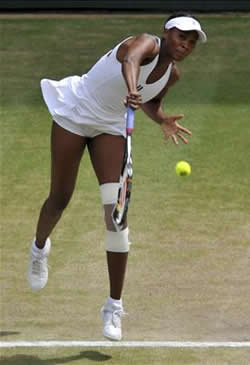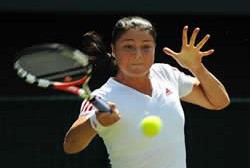The Safina Rule: Notes on a Wimbledon aftermath
 Dinara Safina’s 6-1, 6-0 loss to Venus Williams in Wimbledon’s easily-forgotten “other semifinal” might have taken only 50 minutes, but the impact of the event is still being felt throughout the WTA Tour.
Dinara Safina’s 6-1, 6-0 loss to Venus Williams in Wimbledon’s easily-forgotten “other semifinal” might have taken only 50 minutes, but the impact of the event is still being felt throughout the WTA Tour.
The biggest story of this year’s ladies’ singles tournament at Wimbledon centered around the Williams sisters, back in the final of the world’s most prestigious event. The best match of The Championships jumped off the page, as Serena Williams’s heartstopping triumph over Elena Dementieva electrified women’s tennis at a point of low ebb for the sport. The loudest controversy of the fortnight-literally and figuratively-came from the lungs of 16-year-old Michelle Larcher de Brito, whose screaming during rallies sent the British tabloids into a publishing frenzy. But the most significant story of the tournament-the narrative that produced the kind of debate sports fans crave-emerged when Safina, still possessing that “(1)” next to her name on the draw sheet, claimed just one game and 20 total points (that’s right-just 20 total points in 13 games; you try winning a tennis match when you get roughly 1.5 points per game…) against an ascendant Venus on Centre Court. The fact that Safina still owned the world’s No. 1 ranking only made the reality of her lopsided defeat that much more embarrassing. The problem, though, lies not with Safina herself, but with the WTA’s ranking system. As the ladies’ tournament at Wimbledon comes to a close (at press time, the Williams sisters are beginning their much-anticipated singles final), it’s worth discussing the ins and outs of tennis rankings and the players caught up in such controversies.
It was striking to read the transcript of Venus Williams’s post-match press conference following her slaughter of Safina. Assembled journalists-understandably wanting to explore the incongruities inherent in a breadstick-and-bagel beatdown suffered by the world No. 1-pressed Venus about the legitimacy of Safina’s ranking, and what that meant for women’s tennis. The words themselves tell the story:
Q. This isn’t your fault obviously because you played really well, but it’s embarrassing for women’s tennis to see the No. 1 destroyed in that way, isn’t it?
VENUS WILLIAMS: Why do you put it like that?
Q. You played very well.
VENUS: Are you trying to be down on women’s tennis?
Q: I’m trying to be down on the way that Safina is the world No. 1 representing women’s tennis.
VENUS: So you’re trying to be down basically.
Q: Not on women’s tennis, no.
VENUS: Okay, because I don’t deal with down at all.
Q. It’s not down.
VENUS: I’m just making sure you’re not trying to be down, because I respect Dinara Safina immensely, and I think you should, too.
Q. I do. . .
VENUS: Thanks.
* * *
It was, on one hand, a joy to see Venus doing what any self-respecting women’s tennis player should have done: Defend Dinara Safina. That feeling, however, was tempered by the unfortunate realization that the questioner failed to make the right kind of inquiry.
An appropriate line of questioning would have involved a reference to the ranking system used by the WTA Tour, not any reference to the Safina’s deficiencies. Safina, it must be said, battled to the semis of Wimbledon-her best-ever showing at the tournament-despite a case of knee tendonitis and a succession of tough matches against inspired opponents. Safina trailed Amelie Mauresmo by a set and a break, and then found herself down 3-0 in the third and deciding set of Monday’s fourth-round match, but still fought through to the quarterfinals. In the round of eight, Safina’s serve could not be found, but the Russian still willed herself past Sabine Lisicki despite playing anything but her best tennis. Marat Safin‘s sister has been the most consistent week-in, week-out player on tour in 2009; the 23-year-old should be praised for what she achieved at Wimbledon.
Safina’s lopsided loss to Venus Williams should not have surprised anyone in the women’s tennis community. Venus, first of all, is a woman who loves grass as much as Safina hates it. Centre Court is Venus’s cozy summer cottage, while Safina despises the green stuff and the unreliable bounces it provides. Venus has won five times at SW19, and against an injured foe (never mind Venus’s own wrapped knees; they’ve plainly not limited her on-court movement this fortnight), she simply had every possible factor pointing in her direction. The matchup was a bad one to begin with for Safina; failing to do much against Venus Williams at Wimbledon is no sin at all. If journalists feel Dinara Safina is the problem in this episode, they have a horribly wrong-headed impression of the matter.
Indeed, the focus of the interviewers at Venus’s post-match presser should have zeroed in on a system that allows Safina to claim the No. 1 ranking without having won a single slam title. Safina didn’t make the WTA’s rules or procedures; she’s merely trying to play her best tennis. Yet, in this and previous tournaments (the Australian Open and the French Open), the Russian was pelted with questions about a ranking she inherited, not a ranking she lobbied for. It’s a blessing that rankings in tennis are not so much the result of politics as they are a reflection of numerical formulas otherwise known as point allotments. Tennis has always struggled (same with the men) in determining just how many points to offer for individual tournaments and 12-month periods of competition, and this latest dust-up involving a damsel named Dinara only shows that the sport still has to tweak its methods and maneuvers.
So let it be said, then: Why not insist on a simple set of changes that would immensely improve not just the rankings formula itself, but the public perception of the sport (especially as it rests in the hands of journalists who can quite easily miss the mark)?
A road to a better women’s tennis rankings list would involve these basic improvements:
1) The insertion of a provision requiring a world No. 1 to win a slam title.
2) If the No. 2 player lacks a slam title, make a determination about the point differential needed to allow the No. 3 or No. 4 player to rise to the No. 1 position.
Example: If player A has 9,800 points (as Safina does) and player B has 8,100 points (roughly Serena Williams’s total at the moment) but no slams, should player C, with a slam title to her name, be allowed to ascend to the No. 1 position with 7,200 points? One does have to admit that if a slam-less player is extremely consistent in all other tournaments on the tennis calendar, it is not terrifically easy to say that a less active player should be ranked No. 1, even if that less active player snaps up the slams. This has been the very dynamic that has encased the Williams sisters in recent years: Serena and Venus do not play a full calendar, but they wind up winning many of the year’s majors. Women’s tennis can’t idly watch as slam-less players gain the top ranking, but certain thresholds need to be established in order to give the rankings system credibility.
3) This is the easiest rule to add: If or when a slam-less player with the highest (12-month-based) point total finally wins a slam, that player should be immediately be promoted to the No. 1 ranking.
Yes, the formulation and implementation of a mutually satisfying plan for all female tennis pros would take some time, but in light of the unfortunate controversy surrounding Dinara Safina at this year’s Wimbledon, it’s high time the WTA does something to address the problem. Dinara Safina did what she could in suburban London this year, but journalists viewed her semifinal washout as her great disappointment, when all along, it was the WTA’s ranking system that truly cast a pall over the sport.
With a little care and forethought, future women’s tennis debates-about No. 1 and the health of the sport-can focus more on the results of tournaments, and less on rankings systems that make players the villains. Administrators are the real sources of the sour notes that continue to plague this sport. Safina should not have to be asked to defend a No. 1 ranking she didn’t really deserve, and Venus Williams should not have had to defend her fellow traveler on the WTA Tour.
Tags:
3 Comments »
No comments yet.
RSS feed for comments on this post.
Leave a comment
You must be logged in to post a comment.



